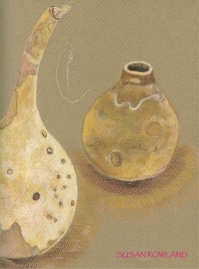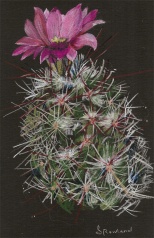Once in a while you come across a couple of bloggers who really catch your attention. You wait eagerly for the next installment.
Today I’d like to introduce you to Dennis Cardiff, an extraordinary listener. His blog is Gotta Find A Home and his new book by the same title: Gotta Find a Home, Conversations with Street People, is coming out soon. Check out the give-away and promos for it.
I found out how talented and modest Dennis is after he agreed to do an interview. He is also a serious artist! Added to his art and writing, Cardiff also is a poet. His own story is one that inspires compassion and motivation.
Here is the interview:
SR: What got you started in writing?
DC: My first wife was a poet. She got me interested in writing. I wrote mostly poetry at that time. I became a voracious reader. I read Tolstoy’s War and Peace in two weeks. I’d read everywhere, even while walking down the sidewalk.
In 1969 I attended York University, Toronto and studied Poetry and Creative writing. I was introduced to some of the best poets from Canada and around the world. My poetry professor once said to us, “If you fully understand what it is you want to say, there is only one combination of words that will thoroughly explain your viewpoint.”
I’ve worked in art galleries most of my life and some of my duties included writing exhibition catalogs, newsletter copy and giving tours. Learning how to subdue a group of high school students, and to mollify a group of nuns, viewing the erotic sculpture of Gaston Lachaise is challenging. This experience taught me the importance of brevity and impact.
SR: So, do you journal? What inspires you?
DC: I have journaled sporadically, but I was away from writing for a long time. Reading Bob Dylan’s book Chronicles: Volume One, gave me more understanding of his writing process, especially deconstructing the work of authors he admired. He made it sound easy.
In 2007 I joined Writing.com where I was able to get feedback on what I had written and encouragement to explore new directions. In April of 2013, I joined WordPress.com and received even more feedback and encouragement, for which I am very thankful.
SR:What called you to write about homeless people? We all seem to categorize people who stand on the streets with signs. We often just pass them by with urgent feelings of avoidance. Why is this?
DC: My first encounter with a panhandler was, when I moved to Toronto in 1968, to live with my older brother, Jack. Being a storyteller himself, he viewed panhandlers as follows: If they present you with an interesting, unique story of why you should give them money, that story has value and should be rewarded accordingly.
My poem The Silver Fox reflects that period of my life.
Slouching in forgotten tap-rooms
dirty old men, forgotten old men,
slop piss-colored beer from, wet, dripping glasses.
The hollow din,
the retelling of “the good old days”,
echoes sadly as life quickly passes.
“They used to call me ‘The Silver Fox’
What do you think of that? They used to care.”
An empty glass crashes
to the muddy floor.
“I guess I’ll be hitting the street tonight.
Sleep in an alley tonight. Nobody cares.”
Slouching
in forgotten tap-rooms
dirty old men, forgotten old men,
slop piss-colored beer. Nobody cares….
Cardiff continues:
In 2010, I noticed a woman seated cross-legged on the sidewalk with her back against a building wall. A snow-covered Buddha, wrapped in a sleeping bag, shivering in the below freezing temperature. I guessed her to be in her forties. Everything about her seemed round. She had the most angelic face, sparkling blue eyes and a beautiful smile. A cap was upturned in front of her. I thought, There but for the grace of God go I. Her smile and blue eyes haunted me all day.
I have always been told not to give money to panhandlers because they’ll just spend it on booze. I thought to myself, What should I do, if anything? What would you do? I asked for advice from a friend who has worked with homeless people. She said, ‘The woman is probably hungry. Why don’t you ask her if she’d like a breakfast sandwich and maybe a coffee?’ This has become a morning routine for the past four years. The woman (I’ll call Joy) and I have become friends. Often I’ll sit with her on the sidewalk. We sometimes meet her companions in the park. They have become my closest friends. I think of them as angels. My life has become much richer for the experience.
I have asked homeless people what could be done to improve their situation. The most eloquent response came from Bearded Bruce.
“I get a welfare check now, seven hundred and thirty-two dollars a month. I’ve never taken welfare before, but I had to in order to qualify for my apartment. It’s a program they started me on in prison. Before that I was content to sleep behind the dumpsters, but after I was crammed in with a bunch of guys for three months, with no privacy, no freedom and I got to talk to my worker in a spacious, quiet interview room… what she was saying sounded pretty good. They pay my landlord directly. It’s subsidized, so that leaves me with about two fifty. A person can’t live on two fifty a month, so I pan when the weather’s decent. There’s a restaurant that gives me their leftover food. When I cook I use a big pot. I have Tupperware containers; one for Shakes, one for Little Jake, one for Chuck. I have to take care of my boys.
“If I wasn’t on this program, the least expensive room, that’s ROOM, mind you, would cost five hundred and thirty a month. It would be in a rooming house crawling with cockroaches, infested with bed bugs, crackheads. Guys running up and down the stairs all night. I’d rather sleep on the street. If the city wants to cure homelessness they need to provide affordable, clean housing.”
SR: It’s amazing how much compassion you have for people, and how your writing and art bring the world alive to the reader, and to the viewer. Where do you find the passion for this kind of work?
DC: What has influenced my life the most was being diagnosed with polio at the age of eighteen months and six major surgeries, one hundred and fifty stitches, over a period of sixty-seven years.
The following poem, The Lost Boys, is biographical.
I was a young boy with a withered leg,
abandoned, in a cold hospital bed.
Faceless attendants wore gloves, masks and gowns.
No parents for cuddles, kisses or love.
Alone were the Lost Boys with polio,
the silent, unpredictable killer.
Quarantined, isolated like lepers,
our only strength came from one another.
Expected to die, we boys joined forces.
We supported each other, forming a bond.
After lights were turned out we would whisper
together, “Shush, the Sisters are coming.”
Older patients had access to wheelchairs.
Sometimes they’d transport me to other wards —
to meet other boys was high adventure.
An empty bed usually meant a death.
Six decades since, in the still of the night,
after lights are out, I can sometimes hear
that haunting refrain I heard as a child, whispered,
“Shush, the Sisters are coming.”
I don’t feel sorry for myself. In fact, I am grateful for polio, it made me what I am today. We all have scars, it’s what we do to overcome those scars is what is important. It seems that for most of my life I have been recovering from one operation or another or fighting arthritis. I lift weights and train at a gym three nights a week. I’m in better shape than most men half my age. I identify with the marginalized because I, too, have been marginalized.
When I sit on the sidewalk with my homeless friends, I see the looks of disgust, the averted eyes, sometimes hear the rude comments. Most people don’t realize that they may be only a couple of paychecks away from being homeless. They don’t realize how quickly the bank will take your house if you lose your employment and can’t make the mortgage payments. They fear that, and don’t want to be reminded of it by panhandlers or the visibly homeless.
*************************
Thank you, Dennis! I’m honored to be highlighting your work. My husband is a polio survivor and also an artist–a woodcarver. Your poem about being a little boy in the hospital resonated deeply. It just goes to show how much people can do when they set their minds to the task.

I encourage readers to buy Gotta Find A Home and to sign up for the blog. Through your writing I feel all your people, from Joy, to Bearded Bruce, Weasel, Shakes, and all the others, especially their pets. Even though the stories of the street people are intense, we are all touched by the true grit of their lives.

























![rae_forbiopage[1]](https://journalwithsue.wordpress.com/wp-content/uploads/2013/06/rae_forbiopage1.jpg?w=840)

